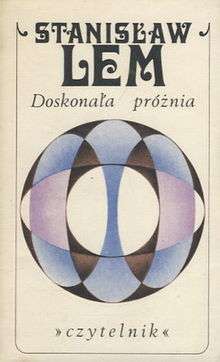A Perfect Vacuum
A Perfect Vacuum (Polish: Doskonała próżnia) is a 1971 book by Polish author Stanisław Lem, the largest and best known collection of Stanislaw Lem's fictitious criticism of nonexisting books.[1] It was translated into English by Michael Kandel. Some of the reviews remind the reader of drafts of his science fiction novels, some read like philosophical pieces across scientific topics, from cosmology to the pervasiveness of computers, finally others satirize and parody everything from the nouveau roman to pornography, Ulysses, authorless writing, and Dostoevsky.

Cover by Andrzej Heidrich
Contents
The book contains reviews of 16 imaginary books and one real book: itself.
- A Perfect Vacuum: review of the book itself, by the author himself.
- Les Robinsonades: A Robinsonade wherein the marooned sailor copes with his solitude by attempting to create an orderly world purely within his imagination - a task doomed to failure.
- Gigamesh: fictional 'Gigamesh' is to the Gilgamesh legend what James Joyce's Ulysses is to Homer's The Odyssey. Lem spends his review doing the same sort of dissection of this fictional novel, word by word, phoneme by phoneme, that critics have been doing to Joyce for years.
- The Sexplosion: a novel concerned with the extinction of the sex drive.
- Gruppenführer Louis XVI is a story about how an ex-Nazi in Argentina recreates the pre-Revolutionary French Court in the jungle.[2]
- Rien du tout, ou la consequence: review of a book written entirely in negations ("The train did not arrive. He did not come.").
- Pericalypsis: - Lem's critique of reviewers and modern art.
- Idiota
- U-Write-It: a publication described as a literary erector set. It gives the reader blank pages and strips containing fragments of some great novel and orders the reader to re-arrange them at will. Similar to the cut-up technique used by the Dadaists and William S. Burroughs.
- Odysseus of Ithaca
- Toi
- Being Inc.: review of a book that portrays the world as the result of elaborate computer planning of individual lives, a huge choreography of humanity
- Die Kultur Als Fehler, or 'Civilization as a mistake': One of Lem's philosophical pieces, he argues that humanity has tried to give meaning to its frailties and weaknesses by claiming they are part of a larger plan of things. Now that technological progress has allowed us to evade many of these hardships, some people oppose that – consciously or not, because it would mean that all the previous suffering has been unnecessary and technology is our saviour.
- De Impossibilitate Vitae and De Impossibilitate Prognoscendi ( ("On the Impossibility of Life" and "On the Impossibility of Prognostication"): two books (by a fictional author Cezar Kouska) reviewed in one review, both dealing with alternative history. This pseudoreview was published in English under the title Odds in 1978 in The New Yorker.[3]
- The former consists almost entirely of tracking all the things that must have happened for the author (Kouska) to have been born: his father must have married his mother, which in turn depended on them meeting during the War, which in turn depended on multitude of other events. Here Lem argues for the butterfly effect: changing one thing has an almost infinite number of unimaginable consequences. De Impossibilitate Vitae is a fictionalized piece of Lem's own biography.[4]
- The latter is an argument that futurology cannot be based on the probability theory, but rather of some other approach, quoting Lem: "namely, to quote Kouska, 'theory, based on antipodal axioms, of the distribution of ensembles in actual fact unparalleled in the space-time continuum of higher-order events.' (The quotation also serves to show that the reading of the work, in the theoretical sections, does present certain difficulties.)"[3]
- Professor Kouska is the namesake of "Kouska's fallacy" in reasoning about concurrent happening of two highly improbable real-life events: in calculating of the probability of such a happening it is fallacious to assume that they are independent.[5][6]
- Non Serviam: Is an elaborate satire of the idea of artificial intelligence that gets to the heart of the moral dilemma that true success would create. It is written in the dry style of a book review that might appear in a broad scientific journal sometime in the near future. It discusses the book, Non Serviam, by Professor James Dobb, and through this the field of "personetics", the simulated creation of truly intelligent beings ("personoids") inside a computer. It starts with a quote that "[personetics is] the cruelest science man ever created." Lem has the erudite reviewer describe the general theory of personetics, the history and state of the art, and some of the consequences, liberally quoting the work of experts in the field. Later the reviewer quotes from the book a discussion that Dobb recorded in which a personoid philosopher, ADAN. considers what he might owe his (unknown) creator. It is clear that this personoid believes he has free will (and so can say, "non serviam", i.e. I choose not to serve). It closes by quoting Dobb's expressed dilemma in having to eventually bring this world to an end. This pseudreview also appeared, in a slightly different form, under the title The Experiment, in 1978 in The New Yorker.[7]
- The translation of the faux review of Non Serviam was included into the 1981 collection of essays The Mind's I.
- The New Cosmogony: review of a fictional oration by a Nobel Prize laureate, who presents a new model of the universe based on his analysis to the Fermi Paradox: the universe is a game.
Reception
- "Lem is Harpo Marx and Franz Kafka and Isaac Asimov rolled up into one and down the white rabbit's hole." (The Detroit News)
- "[Lem is] a Jorge Luis Borges for the Space Age, who plays in earnest with every concept of philosophy and physics, from free will to probability theory." (The New York Times)
- "One of the most intelligent, erudite and comic writers working today." Anthony Burgess (The Observer)
2008 edition
The 2008 edition of the book printed by Agora SA contained a supplement by Jacek Dukaj titled Who Wrote Stanisław Lem?, nominated for the 2009 Janusz A. Zajdel Award.[8][9] It is a faux review of a book published in 2071, the book being a discussion of the activities of artificial intelligences, which simulated Stanisław Lem. In fact, Dukaj maintained a column of faux reviews, Alternative Bookstore ("Księgarnia alternatywna") in Polish magazine Science Fiction (from #14 (04/2002) to #33 (12/2003)). In an interview he claimed that it was not an intended continuation of Lem's work; rather he had a number of ideas he didn't have time to develop in full.[10]
The Agora SA edition also contained the "Glossary of Lem's Terminology" ("Słownik terminów Lemowskich") based on Wojciech Orliński's book Co to są sepulki? Wszystko o Lemie (2007) ("What are the Sepulkas? Everything about Lem").
Bibliography
- Stanisław Lem, A Perfect Vacuum, Northwestern University Press, 1999, ISBN 0-8101-1733-9
Notes
- Book's entry on Lem's official page, contains author's notes in English
- This story also appeared, in a slightly different form, under the title Parisia, in The New Yorker on September 18, 1978, pp 36-44.
- Stanislaw Lem, "Odds (A REVIEW OF “DE IMPOSSIBILITATE VITAE” AND “DE IMPOSSIBILITATE PROGNOSCENDI,” BY PROFESSOR CEZAR KOUSKA)", The New Yorker, no. 54, December 11, 1978, pp. 38-54
- Stanisław Lem,Mein Leben ("My Life"), Berlin, 1983
- Mark S. Lubinsky, "Kouska's fallacy: The error of the divided denominator", The Lancet, Volume 328, Issues 8521–8522, 27 December 1986, Pages 1449-1450
- Rob Forsyth, Richard W. Newton, Paediatric Neurology, p. 54
- The Experiment (A Review of "Non Serviam" by James Dobb), The New Yorker, July 24, 1978, pp 26-44.
- "Kto dostanie nagrodę Zajdla"
- Archived August 7, 2011, at the Wayback Machine
- "Kiedy temat bierze pisarza za gardło" Archived 2012-01-12 at the Wayback Machine, an interview with Jacek Dukaj origiginally appeared in magazine Lampa, no. 25, 04/2006
References
- Peter Swirski, ed. (2006). The art and science of Stanislaw Lem. McGill-Queen's Press. ISBN 0-7735-3046-0.
